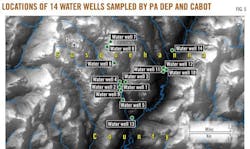P. 5 ~ Continued - Methane in Pennsylvania water wells unrelated to Marcellus shale fracturing
Displaying 5/10
View Article as Single page
Historical salt water and mineral springs are coincident with these predominant lineations, likely indicating that the fracture networks are continuous from the ground surface to the depth of the more brackish Lock Haven lithologies.13
Water wells completed in these fractured, gas-charged sandstones can therefore be expected to encounter gas of thermogenic origin. Water well drillers report that methane gas is frequently encountered while drilling water wells in Susquehanna County, particularly in lowland areas.2
In addition, the Pennsylvania DEP and other state of Pennsylvania agencies have issued guidelines recommending the routine venting of water wells due to the potential for methane gas accumulation from natural sources.25
The elevated levels of dissolved methane observed within valleys in Susquehanna County could be related to two possible geologic sources.
First, faults and fractures in the Upper Devonian Catskill and Lock Haven formations, which act as natural weak points for the formation of valleys, can serve as likely pathways for the transport of thermogenic methane from Upper Devonian formations into the shallow subsurface, presenting as seeps and springs in lowland areas (e.g., Salt Springs State Park).
In addition, the thicker alluvial deposits in valleys may serve to impede or confine the upward diffusion of thermogenic methane gas from the underlying Upper Devonian deposits, thereby contributing to elevated methane concentrations in the shallow subsurface.
The fact that uncased "openhole" water wells commonly draw water from multiple stratigraphic units and fracture zones at depth lends support to the potential thermogenic (vs. biogenic) origin of the methane gas, particularly for wells that extend to the depth of the Catskill sandstone. However, as valleys exhibit a greater accumulation of alluvial sediments than surrounding areas, natural biodecay of the organic material in peats and other sediments could also contribute biogenic gas to local groundwater.
Isotope analysis of water well gas
Isotope and other compositional analyses are useful tools for discerning between biogenic and thermogenic gas sources, as well as different sources of thermogenic gas in the subsurface.26
To characterize gas sources within water wells in Susquehanna County, isotopic data have been reviewed from 5 gas wells, 14 water wells, and one natural spring sampled by the Pennsylvania DEP and Cabot, as well as 9 water well samples analyzed in the same area during the recent study by the team from Duke University.1
During 2009 and 2010, in response to elevated methane concentration measurements in water wells in the town of Dimock in Susquehanna County, the Pennsylvania DEP conducted stable isotope and compositional analyses of gases from nearby shale gas extraction wells as part of an effort to determine the source of this stray gas migration (Fig. 5).
Based on a comparison of Marcellus production gases to overlying Upper and-or Middle Devonian gases encountered within the open annulus of a wellbore, the Pennsylvania DEP determined that the isotopic signatures of shallower thermogenic Upper/Middle Devonian gases and deeper Marcellus Shale production gases, although similar, are distinguishable in this area.27 28
The distinction between Marcellus and overlying Upper/Middle Devonian shale gases was based on a combination of carbon and hydrogen isotopic compositions of methane, which are typically expressed as δ13C and δ2H values. These δ13C and δ2H values proved to be valuable geochemical fingerprinting tools for identifying the subtle differences between shallower and deeper thermogenic sources in the Dimock area.
Differences in carbon and hydrogen isotopic compositions may be attributed to the increased thermal alteration experienced by organic matter in deeper formations, which can result in progressively more positive δ13C and δ2H values of methane that plot along a "thermal maturation pathway" trend.29-31 Additionally, different sources of organic matter may result in distinct stable isotope compositions.
Displaying 5/10
View Article as Single page



